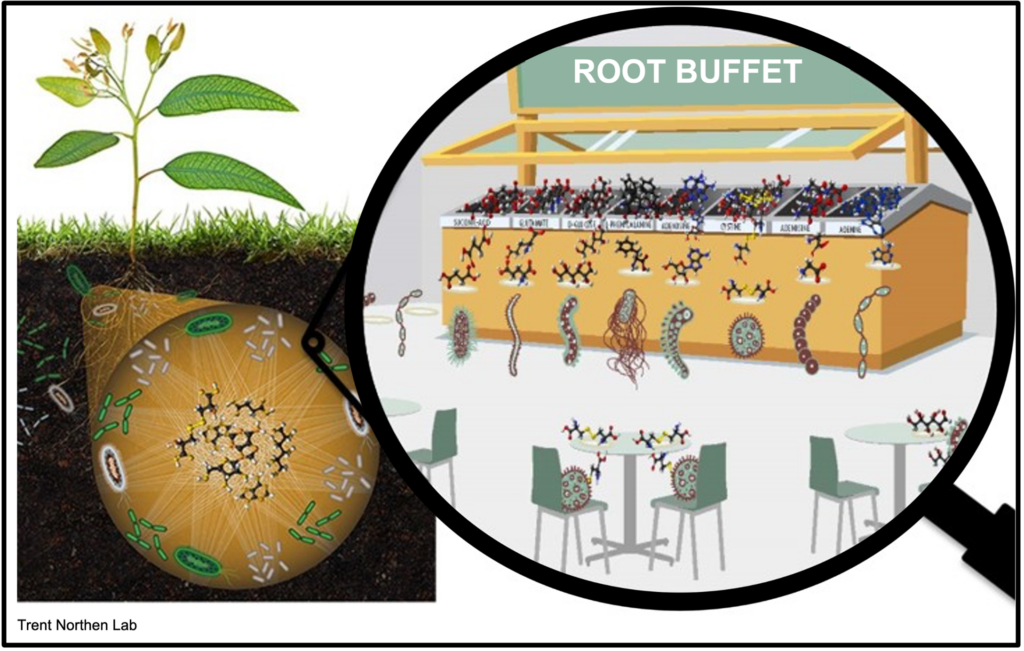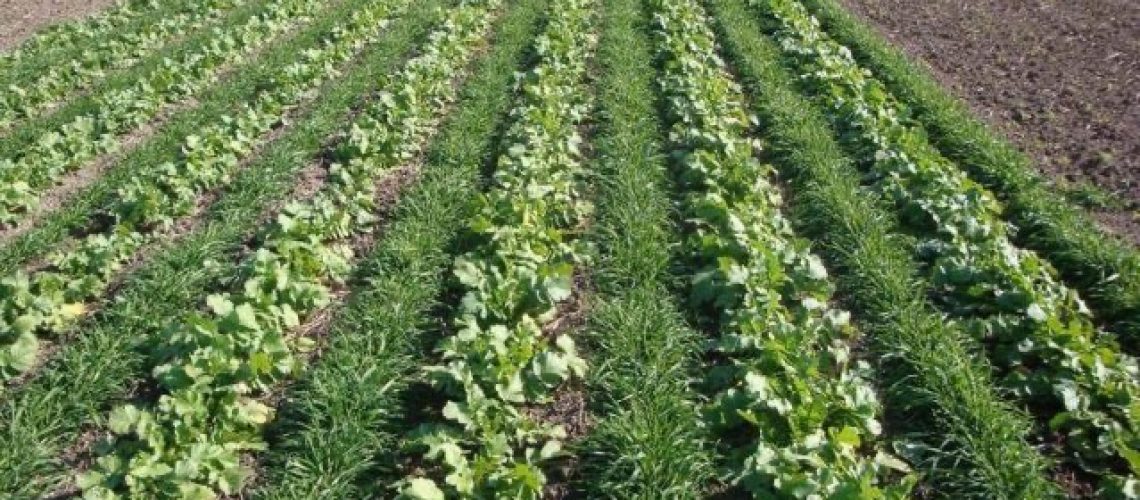Guest Post by Valerie Seitz, 2022-2023 Sustainability Leadership Fellow, and Ph.D. Candidate in the Department of Horticulture and Landscape Architecture & Cell and Molecular Biology at Colorado State University
How can agricultural practices sustainably improve yields to meet rising global food demand?
It likely comes as no shock that the global population is increasing. Current estimates expect the population to reach 9.8 billion by 2050 which is accompanied by a two-fold increase in global food demand (1). The vast majority of additional food will need to come from increases in crop production. But what if there is not enough land to increase crop production? This question hints at the possibility of increasing crop yields on the same arable land producers have used for centuries.
So how exactly do we sustainably increase crop yields to accommodate a growing population? Many believe the answer lies within the soil. Soil is the foundation of our agriculture, and if mismanagement of soil resources continues to diminish the fertility of soils and the amount of productive land, then we will have lost an essential pillar of sustainable agriculture. To maintain the productivity of agricultural soils to meet increasing food demand, our living soils need sustainable solutions.
But what does a sustainable agricultural solution look like? Well, it can look like reducing tillage, adopting water management solutions that use less water, or planting a diverse array of crops, like cover crops, to promote soil health.
What are Cover Crops?
Cover crops are secondary crops that are sown between crop rotations to promote soil fertility and assist in the growth of a primary crop. Cover crops can also be intercropped or planted with a cash crop (a crop that is harvested for a profit such as corn). Types of cover crops used range from grasses to legumes and brassicas, each with their own unique benefits. Cover crops, in general, can be used to promote soil health by increasing water filtration, suppressing harmful pathogens and weeds, and increasing carbon and nitrogen content in the soil, which translates to positive effects on crop yields. This type of agricultural management strategy has been used for decades all across the world, on small- and large-scale operations, but only more recently have cover crops been seriously considered to help improve sustainable agricultural.
When assessing the needs of the soil, cover crops may be chosen for a specific utility. For example, in soils that are highly compacted from years of monoculturing and tillage, cover crops like brassicas and legumes are useful because of their penetrating tap root and fibrous lateral roots. Their taproot system anchors plants deeply which aids in reinforcing aggregation of compacted soils when plants grow to maturity. Grasses, on the other hand, are annual cereals that mature quickly, and their fibrous root structure protects against wind and soil erosion while grass residues add organic matter to the soil (2). Grasses are also the most common type of cover crop used due to their versatility (3). Brassicas, alternatively, can function as biofumigants and protects cash crops against weeds and pathogens (4). Cover crops, therefore, are diverse in the function and varied in their use.
Cover crops can impart these benefits and improve soil health through their interaction between their roots, which exude small molecules (i.e., “root exudates”) into the soil, and the soil microbiome which is the community of microorganisms (bacteria, archaea, fungi, etc.) that inhabit the soil. These microscopic partnerships play a huge role in the success of our cash crops. Because of this interaction, cover crops offer an attractive sustainable solution to managing healthy soils while dually boasting increasing crop yields and the reduced need for tillage and use of pesticides and herbicides which can be detrimental to soil infrastructures. This is currently a large active area of research that aims at understanding how different types of cover crops are best used, managed, and matched with cash crops.
Current research has shown that each cover crop species has its own metabolic “signature” it releases into the soil (3, 5, 6), meaning each species of cover crop releases a different buffet of small molecules into the soil for microbial partners to dish up on! (8).

When soil microbes have access to different buffets (or carbon resources) to feed upon, research shows that this has a dramatic effect on who inhabits the soil microbiome, how they function in that environment, and what they can do help to promote healthier crops (4).
In general, cover crop roots passively release a chemical milieu of compounds into the soil for microbial partners to use as nutrient sources or signaling molecules. Many of these compounds are small and are called primary root exudates which originate from primary plant metabolism and consist of molecules such as simple and complex sugars, amino acids, and organic acids. In some cases, larger root exudates such as proteins and complex secondary plant metabolites can be released in the soil microbiome as well. To make things even more complicated, each species of plant releases a unique root exudate profile into the soil. For example, leguminous cover crops release isoflavonoids which can attract specific types of bacteria that help these crops fix nitrogen (7). This process reduces the need for fertilizers and provides nitrogen to the soils and soil microbes for mineralization, which is a natural part of the nitrogen cycle in soils. Therefore, root exudates play a huge role in the plant-microbiome ecosystem as they can influence soil nutrient availability, pH, and assemblage of the soil microbiome – all necessary components to consider for a healthy soil and a high-yield cash crop. By understanding the role of cover crop root exudates and the impact on the soil microbiome, we can aim to more precisely and sustainably match cover crops to cash crops based on the existing soil characteristics, enhancing the health and sustainability of our irreplaceable agricultural systems.
Conclusion:
What does this all mean for future sustainability? Currently, there is a growing effort to protect arable soils to maintain crop production on existing lands and create healthier ecosystem structures in agricultural management systems to more holistically address the rise in food demands. By embracing modern-day conservation techniques, we can pave the way for intentional management of agricultural soils and their microbiomes to enhance soil health through cover crop selection and continue to provide food for a growing population.
References
- “World Population Projected to Reach 9.8 Billion in 2050, and 11.2 Billion in 2100.” United Nations, United Nations, https://www.un.org/en/desa/world-population-projected-reach-98-billion-2050-and-112-billion-2100#:~:text=COVID%2D19-,World%20population%20projected%20to%20reach%209.8%20billion%20in%202050%2C%20and,Nations%20report%20being%20launched%20today.
- Abad, J., I. Hermoso de Mendoza, D. Marín, L. Orcaray, and L. G. Santesteban. “Cover Crops in Viticulture. A Systematic Review (1): <br≫Implications on Soil Characteristics and Biodiversity in Vineyard”. OENO One, vol. 55, no. 1, Mar. 2021, pp.295-12, doi:10.20870/oeno-one.2021.55.1.3599.
- Magdoff, Fred, and Van Harold Es. “Cover Crops.” Building Soils for Better Crops: Ecological Management for Healthy Soils, Sustainable Agriculture Research & Education, College Park, 2021.
- John N. Matthiessen & John A. Kirkegaard (2006) Biofumigation and Enhanced Biodegradation: Opportunity and Challenge in Soilborne Pest and Disease Management, Critical Reviews in Plant Sciences, 25:3, 235-265, DOI: 10.1080/07352680600611543
- Bacq-Labreuil, A., Crawford, J., Mooney, S.J. et al. Cover crop species have contrasting influence upon soil structural genesis and microbial community phenotype. Sci Rep 9, 7473 (2019). https://doi.org/10.1038/s41598-019-43937-6
- Zhalnina, K., Louie, K.B., Hao, Z. et al. Dynamic root exudate chemistry and microbial substrate preferences drive patterns in rhizosphere microbial community assembly. Nat Microbiol 3, 470–480 (2018). https://doi.org/10.1038/s41564-018-0129-3
- García-Calderón M, Pérez-Delgado CM, Palove-Balang P, Betti M, Márquez AJ. Flavonoids and Isoflavonoids Biosynthesis in the Model Legume Lotus japonicus; Connections to Nitrogen Metabolism and Photorespiration. Plants. 2020; 9(6):774. https://doi.org/10.3390/plants9060774
- Northen, Trent. “Trent R. Northen: Biosciences: Berkeley Lab.” Biosciences Area, 14 Sept. 2021, https://biosciences.lbl.gov/profiles/trent-r-northen/.






